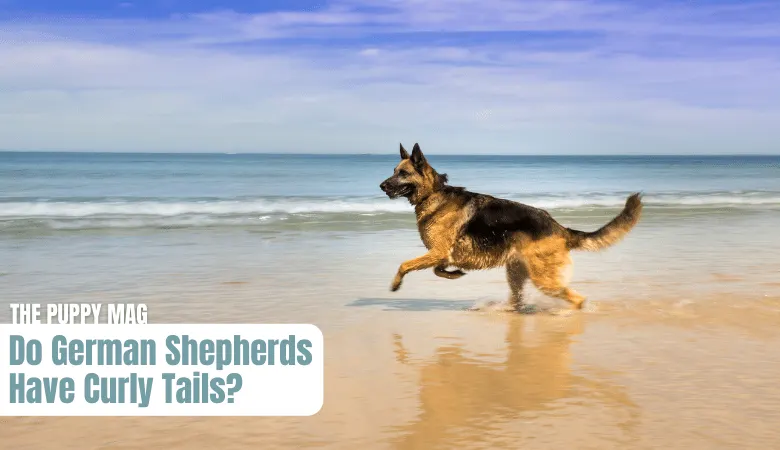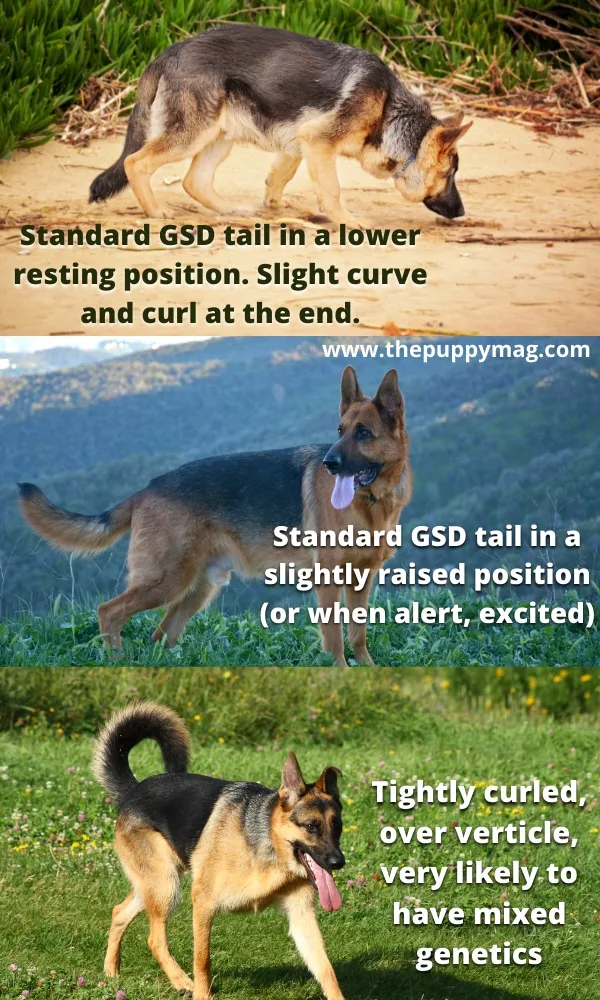Do German Shepherds have curly or straight tails? And what kind of tail should a purebred German Shepherd have? These are great questions, yet there seems to be no concise answer. So this article is here to clear up the confusion about German Shepherd tails. Let’s get into it!
Table of Contents
Can German Shepherds Have Curly Tails?
German Shepherds can have slightly curly tails, although this would be considered a “fault” according to breed standards. Most German Shepherds have straighter tails that hang down with a slight curve.
It’s uncommon, but it can happen. As explained above, German shepherds typically have fairly straight tails.
If the curl is tightly wound, held high, and raps around over the back (over vertical), this suggests that your GSD likely has mixed genetics.
The most common genetic mix causing a tightly curled tail would be from a breed in the spitz family, all of which have tails like this.
Can we be sure of that? Nope, but as GSDs don’t typically have tails that curl over the backside this high, it suggests mixed breeding somewhere in the blood lineage.

What Are German Shepherd Tails Supposed To Look Like?
The next most asked question on this topic is “what kind of tail should a German Shepherd have?”. Most owners ask this in relation to their GSD’s purity, but also to understand the breed standard.
Typical German Shepherd tails follow the line of their croup (lower back) smoothly down to their hock joint (ankle).
When resting the tail should hang lower rather than high, predominantly straight but with a slight curve like a saber sword. When excited the tail will likely raise up and be held in somewhat of a higher position. This is taken (but changed to my own words) from the AKC German Shepherd Breed Standard.
It’s also possible for the tail to slightly “hook” or sway over to one side.
Photo Examples:

The end of the tail can sometimes be straight or slightly curled. If it’s curled, this is considered a “fault” in terms of breed standards. Although this doesn’t mean your GSD has something “wrong” with her or that she isn’t purebred.

Is Your German Shepherd Purebred With a Curly Tail?
Many owners worry about their GSD’s purity if their tail is curly.
A curly tail or otherwise known as “gay tail” isn’t a reliable factor to go by ALONE in determining whether your German Shepherd is purebred.
Just because your GSD has a curly tail, it doesn’t necessarily mean she isn’t a purebred. Unless it’s extremely curly to the point it curls over the back, then the chances of mix breeding are higher.
Genetic make-up plays the most significant role in the appearance of your GSD, as do inherited faults and unique body structure differences.
The only true way to know if your GSD is purebred is to have a DNA test done or have official documentation of both parents stating that they are purebred.
Trending Article: Would a GSD attack its own owner? Is it possible?
Do German Shepherd Puppies Have Curly Tails?
When it comes to GSD puppies, tail position and “curliness” vary even more than in adults. Many owners make the similarity between how a GSD’s ears will dance around up and down before “settling” into their adult position.
Some puppies will hold their tails in a different position to what they will have when they’re an adult… It’s certainly possible that your GSD puppy has a curly tail, and holds it higher than usual, but that doesn’t necessarily mean that’s how it will end up when he’s older. This is very important to keep in mind.
Additionally, tail positions change depending on their current mood, feelings, and temperament. Puppies that are excited and playful will almost always have a raised tail, but this might drop down when they are either calm, resting, nervous, fearful, or anxious.
On the other hand, if your GSD puppy has an extremely curled tail that sits high over his back, this does point towards mixed genetics.
Caring For a German Shepherd Tail
Check out the following tips that will help you keep your GSD’s tail healthy and in top condition.
1. Brush Regularly
Most GSD owners already know that having a regular brushing routine is extremely important. The issue, however, is that the tail is often neglected for other pairs of the body such as the back and neck.
The tail needs just as much brushing! Be sure to spend an extra couple of minutes focusing solely on the tail. The best brush for the tail would be a quality slicker brush.
2. Wipe The Tail Regularly
Tails vary in length and fluffiness, but if your GSD’s tail sweeps along the floor, be sure to regularly wipe the tail with some dog-friendly grooming wipes, or if you don’t have those, good old baby wipes are fine.
This is essentially a mini bath, without the hassle, and without risking those essential oils. A quick baby wipe of the tail will help keep muck, dirt, and bacteria from building up.
3. You Don’t Need To Trim The Hair
There’s somewhat of a myth that the ends of the hairs on a GSD’s tail are sensitive. In fact, some owners believe that “gay tail” or a curly tail, could be caused when the hairs on the end of the tail constantly drag on the floor. This sensitivity then causes the GSD to curl the tail upwards.
Although this makes sense, to a certain degree, there has been no scientific evidence or any substantial research to back up this claim. Ideally, you should never be trimming or cutting the hair on your GSD’s tail.
4. Prevent Your GSD From Tail Chasing or Biting
Tail chasing or tail biting can lead to hair loss, sensitive skin, wounds, infections, and more, so it’s a very good idea to curb this behavior the moment you see it happening.
Redirection training will likely be your best bet, but this will take time and consistency on your part to ensure you redirect your GSD on to something else, every single time he tries biting his tail.
Tail chasing/biting could be an indication that your GSD is nervous, anxious, bored under-stimulated (physically and/or mentally), or is suffering from anal furunculosis (if you notice a swollen anus contact your veterinarian). Try making improvements in certain areas of your GSD’s daily routine to see if this reduces the tail chasing.
Additionally, be sure to have a quick inspection of the bum area. Anal Furunculosis is another potential cause of tail biting. This is a chronic, progressive inflammatory disease and will need veterinary attention. You’ll likely see a swelling or general irritation around the anus if this is the case.
5. Carry Out Regular Inspections
It’s a good idea to make it a habit of checking and inspecting the tail at least on a weekly basis, just to ensure everything looks good and free from rashes, wounds, hair loss, and any other unusual issue.
A casual look and feel while your GSD is calm and relaxed in the evening times could get you in front of any potential problems.
Last thoughts
German Shepherds typically have straight tails that hang down with a slight curve, similar to that of a saber sword. While it is very possible and even common for the tails to be slightly curled at the end, this does count as a breed “fault” according to the AKC.
If a German Shepherd has a tightly curled tail that sits high up, curling over the back, this is a strong indication that he has mixed genetics.
Curled tails are known as “gay tails” and are usually an undesirable trait for most GSD owners.
But you can rest assured, curled tails are not an indication that there is something “wrong” with your GSD, and he or she will be fully capable of living a great, happy life.
What kind of tail does your German Shepherd have?
Let me know if this article has helped you if you have further questions!
Thanks for reading!
Be sure to check out our other German Shepherd articles here on The Puppy Mag
